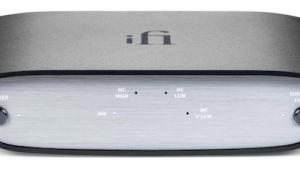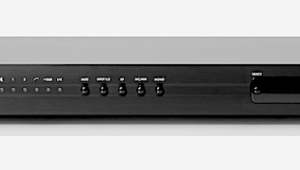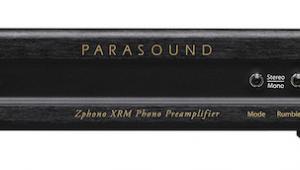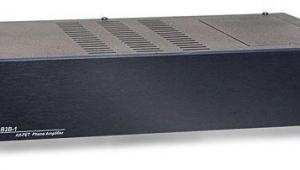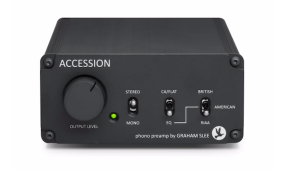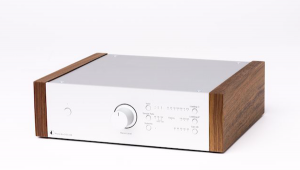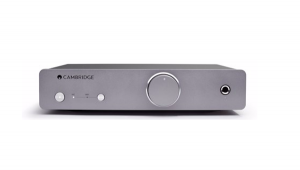I have no idea what's going on inside this device, but I'll sing its praises when it comes to what's outside: proper phono inputs rather than the ghastly, cheap junk that even some high-price products use. The cheapies make marginal contact on day one, then go intermittent from flexing against the PCB if you plug 'em and unplug 'em frequently and ultimately fall apart in your hand when you pull out a tight cable.
---
Praise also for the power supply lead: a screw-on connector and proper strain relief. Regardless of sound quality, I like equipment that's built to last and employs good electronic housekeeping.
Can Aurorasound’s VIDA MkII Phono Preamp Prioritize Clarity and Detail While Also Achieving Precise Imaging and Neutral Tonal Balance?

Aurorasound is a Japanese manufacturer based in Yokohama who make DACs, power amps, preamps, phono preamps, step-up transformers (a.k.a. SUTs), and headphone amps. Some of them come with a decidedly retro look that I find appealing, but curious. The veneer wrap of Aurorasound products greatly resembles that of my 1975 Lafayette integrated amp, but that’s certainly no reason to discount this fabulous machine of theirs we see here before us today, the VIDA MkII phono preamp.
Based in Apple Valley, California (cue Jimmy Stewart), High End Electronics distributes Aurorasound gear here Stateside (that gear is, of course, also available internationally). Aurorasound founder and designer Shinobu Karaki has 28 years’ worth of experience working for Texas Instruments Japan, Inc., and he’s also a musician, music teacher, and dedicated audiophile. According to the parent company’s site, “His love of music, combined with trained ears and extensive know-how in electronics and integrated circuits, makes Mr. Karaki well-suited to design high-end audio components.” No arguments here. Let’s find out more about Mr., Karaki’s latest iteration in the company’s phono preamp line — or, more specifically, today’s test subject, the Aurorasound VIDA MkII.

Specs & Features
Aurorasound products are smartly made, thoughtfully designed components. The Aurorasound VIDA MkII phono preamp (SRP: $5,290) sports an orange light on its façade that appears to be the power switch — but it is, in fact, a mute button. Other options on the front panel include switches for stereo/mono, direct/subsonic filter, high/low impedance, MC/MM, and Phono-1/Phono-2, should you choose the option for a second phono input. Connected by a sturdy DIN cable as seen above and below, a compact and sturdy power supply unit contains the rocker power switch, though I left this solid-state device powered 24/7.
The VIDA MkII offers multiple ins and outs. One moving magnet (MM) RCA input offers gain of 40dB, 47kohm. A moving coil (MC) RCA input is spec’ed to work at a high of 10-100ohms or a low of 0.6-10ohms. A second MC RCA input adds $250 to the SRP. An optional rotary switch that allows for a choice of six impedance settings for MC carts (which was included on my review sample) is available for $750. Finally, one line-level output (RCA), and an optional balanced output (XLR), runs $1,000.
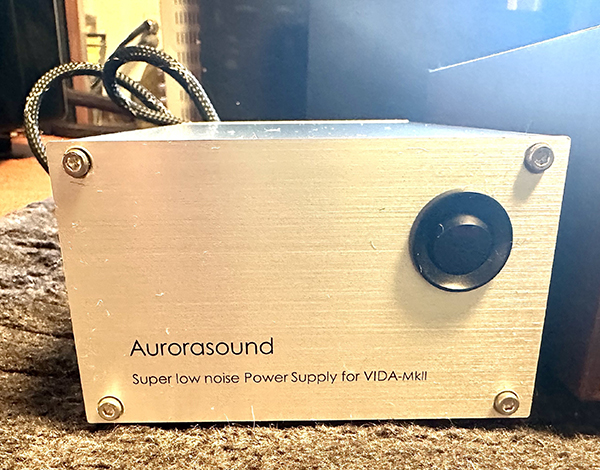
The main VIDA MkII phono preamp unit stands 9.84 x 4 x 10in (w/h/d), while the smaller companion power supply measures 5 x 2.75 x 7in (w/h/d). These seemingly diminutive components pack a clout of sound, let me tell you.
From the High End Electronics site, we learn that “small signals recorded on the vinyl disc must be precisely restored to a flat response using (L) coil and CR network circuit, which go through the RIAA curve, having attenuated lows and boosted highs. At the same time, it must be amplified by roughly 1,600 times (in case of MC cartridges). Since amplification is very large, any noise from the power supply and the circuits must be reduced to a minimum. VIDA [MkII] manages to achieve very high S/N ratio due to a careful selection of components, circuit design and PC board pattern configurations.”
Also per that site, we learn the “precision DC circuit with the latest semiconductor technology eliminates all capacitors in the signal path. It enables a completely flat frequency response without any coloration across the entire audible range. The active DC servo circuit permits stable output regardless of fluctuations in the inputs and operating temperature. Resolution and distortion in low frequencies are improved significantly, therefore, you will be able to even sense and feel the atmosphere of the music hall, performers, and the staging.”
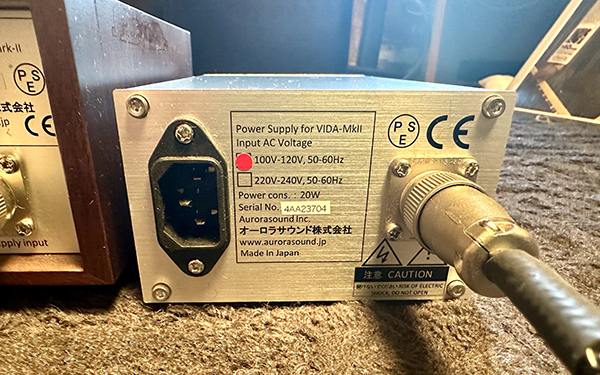
The VIDA MkII power supply uses a toroidal transformer and a Schottky barrier diode, the latter of which “allows ultra-low noise. Any leakage flux noises are eliminated with use of a separate power supply by employing a high-speed semiconductor-based stable power supply circuit.”
Eschewing tubes, the VIDA MkII “manages a compact size thanks to the latest semiconductor technologies. Each component is placed according to the signal flow in symmetrical and the shortest route. The EQ circuit uses the renowned Swedish Lundahl filter-coil, which is widely used in the professional equipment for [roll-off] independently.”
The Aurorasound VIDA MkII is a well-built device, using high-quality components, in a clever design. What listener wouldn’t appreciate a second turntable input, multiple impedance load options, mono/stereo switch, and a MC/MM selector, all on the front panel?

Setup
For the purposes of this review, my system included an EMT 928 II turntable, EMT 909-HI tonearm, EMT JSD Pure Black MC cartridge, Tavish Design Adagio phono preamp, Riviera Levante integrated amp, Volti Audio Razz loudspeakers, and cabling from AudioQuest and Triode Wire Labs. Once everything was properly connected, it was time to put the VIDA MkII through its paces.
Listening Sessions
Every record played through the Aurorasound VIDA MkII phono preamp shone with newfound clarity and focus, revealing intricate details I hadn’t noticed before. When the needle hit the wax, the VIDA MkII laid down a challenge so emphatic it felt like tossing a high-fidelity gauntlet. Take Cal Tjader’s Latin Kick, an original 1958 Fantasy pressing soon to be a new OJC reissue from Craft Recordings. Through my trusty Tavish Design Adagio — my long-term phono preamp reference — Cal’s vibes shimmered in a golden haze, and the whole band was a well-lubricated barroom unit. The VIDA MkII, however, pierced through that comfortable haze. It was like injecting the scene with a shot of sonic espresso.
Each instrument was sharpened, and distinct within a soundstage that bloomed outwards — vaster, deeper. The music pulsed with a newfound vitality, the dynamics kicking like an angry mule. Resolution increased — clarity, imaging, detail, treble extension — all blooming outward and clean. Bass, though softer, packed better focus. Cal’s vibes retained their signature halo, but now they occupied a distinct space within this meticulously layered sonic landscape. The message was clear — the VIDA MkII wasn’t here to mess around.

The VIDA MkII’s crusade for sonic clarity continued with the 2014 version of Thelonious Monk Septet’s 1957 offering, Monk’s Music (Riverside OJC 084), another Craft OJC in waiting. Where the Tavish Adagio rendered Monk rich and imposing, the VIDA MkII coaxed a deeper, larger, cleaner sigh from the mini-horn choir on the album-opening “Abide With Me” (Side 1, Track 1), imbuing their lament with a newfound presence. The VIDA MkII also unearthed a wealth of previously unheard detail and dimension from the record’s smallish mono center spot. Art Blakey’s cymbals shimmered with sweeter tone — albeit less prominent, their energy was more audible within the VIDA MkII’s expansive sonic landscape. Wilbur Ware’s bass lines, meanwhile, crackled with a newfound clarity and punch.
And then came that infamous moment in “Well, You Needn’t” (Side 1, Track 2) — Monk’s primal scream of “Coltrane! Coltrane!” before the then-recently detoxified tenor saxophonist launched into his solo. Through the VIDA MkII, the urgency in Monk’s voice was palpable — the most powerful, pronounced rendition of it I’ve ever encountered.
I could go on about how the Aurorasound VIDA MkII reanimated cherished Blue Note pressings like Dexter Gordon’s Doin’ Allright (1961; Blue Note New York BLP 4077), Kenny Dorham’s Whistle Stop (1961; Blue Note Liberty BST 84063), Sonny Clark’s Trio (1958; Blue Note Liberty BST 81579), and Walter Davis Jr.’s Davis Cup (1960; Blue Note United Artists BLP 4018) — all of them punching though my room with gusto and intent. The VIDA MkII made each of these LP listening experiences special in their own respective ways.
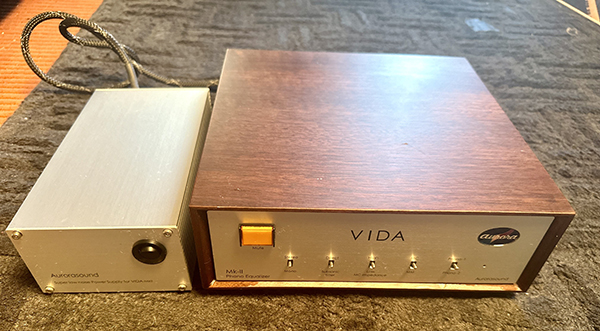
Conclusions
Sometimes, we can’t confirm how a component sounds until comparing it to a similar component. Contrasting dynamic range, tonal color, imaging, and clarity can reveal distinct sonic qualities. My aforementioned long-term phono preamp reference, the Tavish Design Adagio, delivers a classic tube sound — full-bodied, full-toned, and expansive. It paints a wide soundstage with tonal warmth to spare. The Aurorasound VIDA MkII offered a contrasting experience. It prioritized clarity and detail, with precise imaging and neutral tonal balance. The VIDA MkII’s high frequencies are clean and extended, the mids transparent, and the bass tight, controlled, and sometimes lean.
To reiterate the cost, the Aurorasound VIDA MkII phono preamp goes for $5,290 — a sum as distant from the realm of affordability as a dry-aged New York strip is from a roadside hamburger. What else lurks at this price point, midway between budgetary constraint and Olympian excess, you ask? Are there contenders in this particular niche of the phono preamp market? As it turns out, there are plenty of ’em. You’ve got the Naim SuperLine ($4,599), Boulder 508 ($5,250), Zesto Audio Andros II ($5.900), and one I’d love to hear, the EAT E-Glo S ($3,599).
And now, we can add the wholly worthy and totally amazing Aurorasound VIDA MkII to that competitive phono preamps auditioning list — a top-shelf component if ever there was. Add the VIDA MkII to your own system, and see/hear for yourself.
For more about Aurorasound, go here.
To find authorized international Aurorasound distributors, go here.
For U.S. distribution of Aurorasound products, go here.
Author bio: Former musician, former artist, and former legal wastrel Ken Micallef has written numerous hi-fi equipment reviews for Stereophile and Analog Planet, and his byline has also appeared within Mojo, Electronic Musician, and The Grammys. You can also find him at YouTube (Ken Micallef Jazz Vinyl Audiophile).

- Log in or register to post comments


Love phono preamps, I would like to have a collection of them the way people have multiple phono cartridges. This one will definitely be on my short list to add to the fold.

What a nice post! Thank you so much and I am really looking forward to reading more and more articles from you.candy clicker

Japan's manufactured products are of the best quality. We should have this in our Office cleanouts. I will definitely recommend this surely.

There is something special for everyone at Hippodrome Casino in the UK: from classic roulette and blackjack to the latest video slots with amazing bonus features. You will find games with real dealers 24/7, which makes every session special. For regular players, a unique loyalty program has been developed that rewards for every bet. Regardless of whether you are a beginner or an experienced player, it will give you unforgettable emotions.





